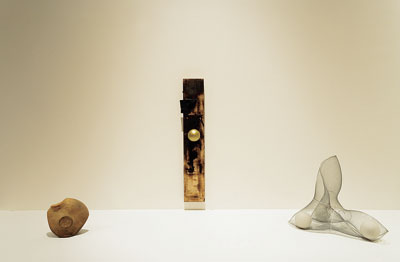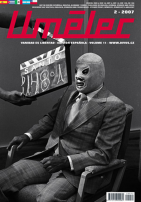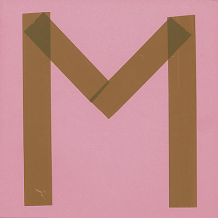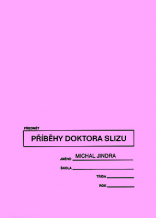| Umělec 2007/2 >> Gabriel Orozco in Bellas Artes | Просмотр всех номеров | ||||||||||||
|
|||||||||||||
Gabriel Orozco in Bellas ArtesUmělec 2007/201.02.2007 Alfredo Flores Richaud | review | en cs de es |
|||||||||||||
|
To the glory of the most famous, the shortsightedness of their admirers is always attributed -Georg C. Lichtenberg Shoot at contemporary art: there’s a growing sport Ivan de la Nuez, Cuban writer, in Babelia, the cultural supplement of El Pais. ... I attribute to this state of the soul my repugnance of museums. The museum, for me, is all of life. Fernando Pessoa, El Libro del Desasosiego. These three quotations express the three impressions that came to me as I entered the great Palacio de las Bellas Artes (Palace of Fine Arts, Mexico City), and engrossed myself in the Gabriel Orozco retrospective. At first, it seemed to be a presumptuous display. Then, as I tried to distinguish personal disillusionment from the excitement at seeing all those star-struck sycophants in attendance (An exalted visitor wrote in the guestbook, “I love you Gabriel," remaining indifferent to the ostentation of it all, I recognized that the show was pleasant in its simple minimalism. A cult surrounds Gabriel Orozco, one that unconditionally exalts him allowing him total freedom; his statements are applauded and his charms admired throughout the artistic world (1). Take, for instance, the main area of the National Gallery. A simple charcoal drawing of a circle, Stele, breaks the empty space of the central wall facing Piedra que Cede (Stone That Yields). This may have been artistically audacious for museums several years ago, but such ‘daring’ has long since become conventional. Orozco is held in such high esteem in the artistic community that one would think he could do no wrong. Last November, Gabriel Orozco received the second BlueOrange award, one of the most prestigious awards for visual artists given out in Germany, in recognition of his career. But it is that very stature that attracts plaudits, not any inherent creativity. The art world’s attitude to this kind of celebrity has killed any real notion of ‘daring.’ Anyone incapable of error is never really taking a risk. But, one should try to be innovative, and this means renouncing any pretensions at being a provocateur. On display are examples aplenty of his great frottages, rubbings made over the subway floor in Paris; or those dry leaves scattered at random that are, insipidly, replicated from various other frottages, Dadaist and Surrealist experiences, Alechinsky, Jasper Johns, Arp… the list goes on. His handprints over clay in the shape of a heart are very similar in intention to the The Artist as a Fountain, by Bruce Nauman. On his white canvas, printed with tracks made by tennis balls soaked in black paint, the result does not justify the novelty; the wit fails to carry the work. These “actions” refer spectators back to the images of Jackson Pollock, vehement and pensive, moving around and through the great canvas with dripping gestures, manipulating the two-dimensional space. Remember 1951, when Robert Rauschenberg rolled a paint-saturated automobile tire over a vast roll of paper? And, just like that, memories surge from such scenes, consciously or unconsciously, memories that are awakened through this recreation of artistic happenings, revisited over time. But here, in the present, this avant-garde space in the prestigious surroundings of an immaculate marble palace, all I can hear is an infinite loop of enthusiastic praise and flattery. There are the Mesas de Trabajo (Work Tables), with a myriad of casually scattered objects, among which are open shipping boxes that a correspondent sent to the artist’s residence in Tlalpan. We also find some scraps of old rusted metal, a broken silver ball, some small toy cars, bones, leaves, marbles, arrows—trash and novelties found in the street, gathered somewhere as he wandered the planet, or, perhaps recovered from childhood. These are objects he gathers out of curiosity, that he saves with great care, orders with delight, and exhibits without need, grace or purpose. There are some admirable works among Orozco’s diverse artistic output: a skull with a checkerboard pattern drawn across it in pencil (property of the Philadelphia Museum); the etching/engraving of a lotus leaf au naturel, and some small sculptures of mixed materials; A sculpture of a hole formed by a hand, created with, and extended by little wooden pallets. A photographic series comprises a register of acts in reality or of moments from reality: breath on a piano, from roof to roof, extension of reflection, island within an island, leaf with paper clip, total perception; rain over a construction site, a flat football holding water, a circular reflex of water over half a tire in a field, etc: they comprise visions of reality observed through a sensitive eye. Bewilderment at the Great Avant-garde Concert The Alaz (wings) cigarette wraps, the pastel drawings on paper recovered from his youth; the Mexican flags painted on cardboard in which a “hole” substitutes for the national shield, and the “sculptures” of melted rubber foam are at the opposite extreme of artistic achievement. His Samurai Tree series geometric paintings are sustained, perhaps, by interesting geometrical games but they are ultimately decorative and meaningless; pictorially speaking, they are more appropriate to the geometrism of decades past. The video Kites in Jhipur, (running at 29, very long, minutes) depicts kites flying high in the sky, referring inevitably to the really prolonged films of Andy Warhol. But the greatest disappointment is the overall arbitrariness of the retrospective that functions in accord with the values of the prestigious: everything becomes possible, and, therefore, art. Shadows among rings of air “Mock-up, at a 1-to-1 scale, of an architectural pavilion to exhibit sculptures” by an Italian architect of the 1950s. The avant-garde passed from appropriating specific modern art ideas to expropriating the concept of the ready-made (e.g., Shoebox, among many other examples of contemporariness); to adapting something of the expressionism in movies to video; to subtracting something of the scenery in the installation; to appropriating something from theater and dance in the performance, and to knocking-off something of the literary to use in the conceptual. This way, the contemporary notion of the visual arts, implicit in the word avant-garde, is wide open, since it engulfs many languages. In this manner, architecture has been seized; it is reproduced or recreated to scale within the palace, as if a construction of shadows among rings of air—either a great installation-cum-readymade or, depending on the focus, a monumental indoor sculpture, or perhaps architecture within architecture—so admirably turned out for a second bit of exploitation. The architecture-sculpture-installation, pastiche-modernist-avant-garde, built, exhibited and re-placed within the palatial-meringue-art deco architecture is what, in due time, results in the triple exploitation of turning an architectonic-artistic-conceptual juggling act that becomes just an idle boast…and a waste. (2) Observatory The undefined monument to vanity that Orozco built on the shores of Oaxaca is an interpretation of another observatory located in New Delhi. I wonder if this construction, located in a paradisiacal cliff overlooking the Pacific coastline, is a sculpture, an installation, a space to watch the world- or all of these, and more. From my modest perspective, it only spoils the splendid landscape, that part of the world that Orozco pretends to watch. However, he also exhibits schematics, mock-ups and photographs detailing the construction of the monstrosity. These things we have to consider as art, I suppose. Limits of an artificial system One risk of the so-called “avant-garde” is the pre-supposition that any expression made by an artist becomes art merely by virtue of being placed in a gallery or a museum. But still, any passing thought should be sustained by a much more interesting idea. Otherwise, the work only recreates out-of-context reality importing a foreign visual language. An infinite reality, and the perception of such, may be a limitation for any artistic representation, if the concept or the causality is expressed without a valid form that contains and justifies it- that is, expresses it. If an expression is not grasped, it becomes an idea without any transcendence, a mere witticism of the spectacle. That is why, when looking at the wide range of views, languages, media, ambitions, and solutions exhibited in the museum and expressed in Orozco’s notebooks, registered in his drafts, and present in the diagrams of some of his expositions- when I see all that eagerness and diversity, a reflection by Paul Valery comes to mind, like a beacon of light amongst all my confusion: “Conscious thought itself makes of itself an artificial system.” “An artificial system”… this clearly and convincingly explains some of Orozco's works, as well as giving an idea of the avant-garde in general, as personified by this retrospective exhibition occupying all the halls of the Palacio de Bellas Artes. (1) “Success and prestige generate conformity and leads us to interpret art according to the guidelines of our culture, and tenaciously grab certain behaviors” -Suzi Gablik. Is modern art dead? (2) A statement by Blanca Gonzalez Rosas in Proceso magazine #1581 reads as follows: “Considered by Gabriel Orozco as an aunt (Proceso 1569), Mercedes Iturbe (Director of the Palacio de Bellas Artes at the time the exhibition was organized and inaugurated) displayed, in all the exhibition rooms of the Museum, a retrospective of the artist that incurred 3 million, 836 thousand, 748 pesos in expenses –information given by the National Institute of Beaux Arts, INBA, through the Federal Institute of Access to the Public Information- With amounts such as 700 thousand pesos paid in transporting works from abroad to Mexico, 126 thousand for the photographic prints of works exhibited, 67 thousand for the photographic reproduction in situ, and 11 thousand 970 expended on bouquets of flowers for the exposition’s inauguration, among these amounts stands out the 811 thousand 800 pesos exhausted just on the catalog. These expenses are outstanding, not only for their sheer quantities, but especially because they are expenditures that privilege mainly the artist, his commercial promoters and his collectors.” But not necessarily the audience or the citizenship, Blanca Gonzalez adds.
01.02.2007
Рекомендуемые статьи
|
|||||||||||||
|
04.02.2020 10:17
Letošní 50. ročník Art Basel přilákal celkem 93 000 návštěvníků a sběratelů z 80 zemí světa. 290 prémiových galerií představilo umělecká díla od počátku 20. století až po současnost. Hlavní sektor přehlídky, tradičně v prvním patře výstavního prostoru, představil 232 předních galerií z celého světa nabízející umění nejvyšší kvality. Veletrh ukázal vzestupný trend prodeje prostřednictvím galerií jak soukromým sbírkám, tak i institucím. Kromě hlavního veletrhu stály za návštěvu i ty přidružené: Volta, Liste a Photo Basel, k tomu doprovodné programy a výstavy v místních institucích, které kvalitou daleko přesahují hranice města tj. Kunsthalle Basel, Kunstmuseum, Tinguely muzeum nebo Fondation Beyeler.
|

































 We Are Rising National Gallery For You! Go to Kyjov by Krásná Lípa no.37.
We Are Rising National Gallery For You! Go to Kyjov by Krásná Lípa no.37.
Комментарии
Статья не была прокомментированаДобавить новый комментарий